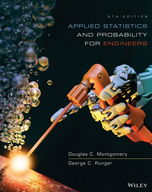Solution Found!
Answer: Suppose that a patient is selected randomly from
Chapter 2, Problem 140E(choose chapter or problem)
Suppose that a patient is selected randomly from those described in Exercise 2-98. Let A denote the event that the patient is in group 1, and let B denote the event for which there is no progression. Determine the following probabilities:
(a) \(P(A \cap B)\)
(b) P(B)
(c) \(P\left(A^{\prime} \cap B\right)\)
(d) \(P(A \cup B)\)
(e) \(P\left(A^{\prime} \cup B\right)\)
Questions & Answers
QUESTION:
Suppose that a patient is selected randomly from those described in Exercise 2-98. Let A denote the event that the patient is in group 1, and let B denote the event for which there is no progression. Determine the following probabilities:
(a) \(P(A \cap B)\)
(b) P(B)
(c) \(P\left(A^{\prime} \cap B\right)\)
(d) \(P(A \cup B)\)
(e) \(P\left(A^{\prime} \cup B\right)\)
ANSWER:Solution:
Step 1 of 3:
The number of patients without progression of joint damage in each group was 76 of 114 patients (67%), 82 of 112 patients (73%), 104 of 120 patients (87%), and 113 of 121 patients (93%) respectively.
Let A denote the event that the patient is in group 1, and let B denote the event that there is no progression.
We have to find the following probabilities.
-
P(A
)
- P(B)
-
P(
-
P(A
-
P(
